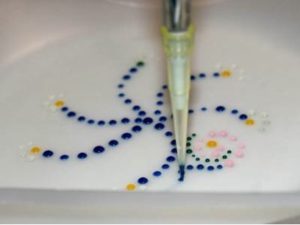Jump to section:
Key Concepts
The micropipette is a ubiquitous tool in every molecular biology lab. Using a pipette precisely and accurately is critical to the success of your experiments. This exercise will provide good practice for pipetting very small volumes (microliters, µl) and ensure that your pipettes are properly calibrated (<1% error).

Materials
- Micropipettes
- Pipette tips
- Food coloring
- Water
- Weigh-boats
Procedure
Familiarize yourself with the pipettes:
-
- Choose a pipette and set it to 5uL, 10uL or 100uL.
- Affix it with an appropriately sized tip and aspirate liquid (water or food coloring) into the tip. NOTE: There are two stops on the pipette. Depress the plunger to the FIRST stop, then submerge the tip in the liquid before slowly releasing the plunger to aspirate the correct volume. When you deliver the liquid, push through until the SECOND stop to ensure all volume is expelled.
- Practice creating uniformly sized droplets on a weigh-boat using food coloring. Be sure to change tips when you change colors or you will mix the colors. Trade pipettes with your lab partner so you can practice with small and large drop sizes. Try to avoid introducing air bubbles into your droplets by gently pushing through the second stop.
- Create a beautiful pointillistic image!
Check your accuracy:
- Choose the correct pipette for accurately dispensing 80µL of water.
- Pipette a row of 10 individual droplets (80µL each) on a fresh weigh-boat.
- Tare the scale with an empty weigh-boat.
- Weigh the weigh-boat with your droplets and calculate the accuracy of your pipetting assuming a density of 0.997g/mL for water. How accurate is your pipet?
Additional information for your future research endeavors
To check the calibration of your pipettes:
- Set the pipette to its maximum volume.
- Tare a weigh-boat on the balance, and then pipette water into it. Record its mass. Re-tare. Repeat three times or until your values differ by no more than 1%.
- Change the volume of your pipette to half its maximum volume and repeat step #2.
- Ensure that the volume of water you are pipetting is within 1% of the expected mass.